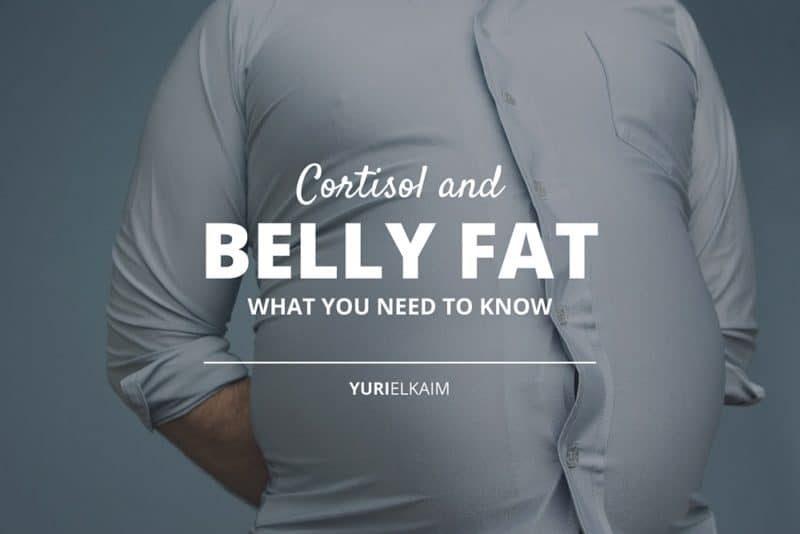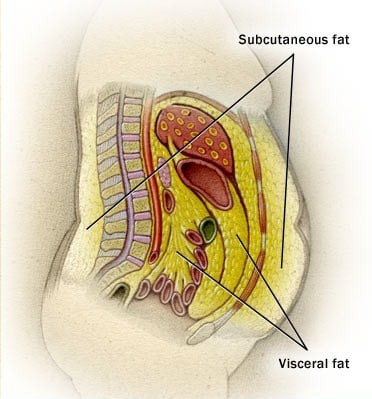In this article
Pick up any fitness magazine and chances are you’ll see a shredded model on the cover, displaying a set of washboard abs.
A flat, tight abdomen is the ideal many of us chase when it comes to having a fit body. And even if a visible 6-pack isn’t your ideal, most of us like the idea of having a trim waistline – not only for looks, but for health.
In other words, we want to ditch the belly fat.
And as luck would (not) have it, that’s the hardest fat of all to blast. And not only that, it’s the most important fat to blast because of its effect on our health.
Why is it so hard to get rid of? Because of the intimate connection between the stress hormone cortisol and belly fat.
The good news is that incorporating some key healthy habits into your lifestyle will go a long way toward helping.
What is Belly Fat?
Sounds like a really stupid question – doesn’t it? But it’s not. In fact, it’s a really great question.
To begin with, there are three basic kinds of fat in the body.
The first is the kind that causes belly fat – it’s called visceral fat, which means that it is lying around the organs located inside the abdomen. It is also called intra-abdominal fat as it lies inside the peritoneal cavity.
Excess visceral fat produces the typical “beer belly” or the “pot belly,” and it’s the kind that is most affected by your hormones. We’ll get into how to manage those hormones – namely, how to reduce cortisol and belly fat storage – in a bit.
The second type of fat is subcutaneous fat, which is the fat lying just underneath the skin, above the muscle – it’s the “pinch an inch” fat that you can grab between two fingers.
There’s also a third kind of fat, commonly known as triglycerides, which is continuously circulating in the blood stream. Triglycerides are constantly in use by the body for a number of metabolic functions.
The visible kinds of fat – visceral and subcutaneous – are your body’s fat storehouses, and they are called upon to contribute to energy requirements when you eat less fuel than you burn.
Why Cortisol and Belly Fat Metabolism Matters
Our bodies store fat when they have an excess of calories available so when there isn’t enough food, we’ll still be fueled. It’s our insurance against starvation and other kinds of stress.
This means that if you consume too much food – more than your daily caloric requirement – your body goes into fat-storage mode.
That’s obviously an oversimplification of fat metabolism that, in fact, is influenced by plenty of other factors that may speed up (or slow down) the process.
The visible kinds of fat – both visceral or subcutaneous – are stored inside fat cells. Although our fat cells aren’t metabolically active, meaning they don’t burn fuel, they are busy secreting hormones and chemicals that have varied effects on the body.
Visceral fat, being near the body’s vital organs, doesn’t have much benefit, though. Cosmetically, it increases abdominal “bloat” and pushes out the front wall of your abs from the inside.
It may be present in large quantities in people who otherwise have a very low subcutaneous fat.
Besides the rotund look it gives to a person, visceral fat is notorious for being associated with chronic diseases of the cardiovascular system and it also has a close association with metabolic syndrome, type 2 diabetes, asthma, and Alzheimer’s disease (1).
So, basically, we can say that visceral fat is bad for your health.
How Does Belly Fat Accumulate?
To understand how to “drive” away the spare tires around the stomach, it is important to understand how we build up belly fat.
The main reason is because people eat more calories than they burn. A surplus of these calories causes accumulation of fat. Also, some conditions causing insulin resistance also result in belly fat getting accumulated.
Also, environmental factors such as maternal smoking and excess consumption of estrogenic compounds may result in visceral fat building up.
But now we get to the biggie that’s the most relevant to today’s lifestyle: cortisol and belly fat storage (2).
Cortisol and Belly Fat
Cortisol is produced by your body’s adrenal glands, which are located just above your kidneys, as a safeguard against emergencies.
Cortisol is released into the body in response to stress and low blood sugar levels. When it’s first released by the adrenals, its goal is to suppress inflammation and make blood sugar levels rise, so your body is prepared to battle whatever is stressing it.
An excess of cortisol circulating in the blood is good for emergencies but very bad when it circulates for a long period.
[Related: 3 Startling Ways Stress Causes Weight Gain]
The high blood sugar levels caused by a constant barrage of cortisol promote the storage of fat in the abdomen (3).
High cortisol levels also causes gluconeogenesis, which means your body breaks its protein reserves into glucose (carbohydrates) to be used as fuel or for storage. It also mobilizes the fat from its storage elsewhere in the body and moves it to the fat abdomenal reserve (4).
When you’re constantly being plowed with stress, it’s easy to see how you body would start to accumulate fat in the belly.
How to Reduce Cortisol and Belly Fat Storage
There are some natural ways you can help you body reduce the amount of cortisol it pumps out and to start shedding belly fat.
1. Lifestyle Modification
Cut back on the number of calories you eat and ramp up how many calories you burn.
That will force you body to dip into your fat stores for fuel, shrinking them.
2. Follow a Healthy Diet Plan
A diet low in simple carbohydrates and rich in protein and fiber is ideal for burning up excess calories. This diet should also contain “healthy” fats in the form of Omega 3 fatty acids and polyunsaturated fats.
3. Work Out
Do some form of exercise 30 to 40 minutes a day.
4. Use High-Intensity Interval Training (HIIT) Workouts
The basic principle of HIIT is to train in alternating intervals of high and low exercise intensities.
As an example, after warming up you could do an all-out sprint for 20 to 30 seconds and then walk or jog (very slowly) for the next 90 odd seconds. Repeat this cycle 6 to 8 times.
[Related: How to Do Interval Training… The Right Way]
HIIT causes an oxygen deficit resulting in a phenomenon called excess post-exercise oxygen consumption that keeps gobbling up calories as fuel for as long as 48 hours after the workout is over.
HIIT is known to target specifically belly fat as it causes certain unique metabolic changes in the body such as increased insulin sensitivity.
Increased insulin sensitivity causes the body to take up blood glucose faster and more efficiently thereby initiating the hormone sensitive lipase which breaks down bodily fat stores.
5. Reduce Stress
Getting rid of stress is a very important intervention to deal with cortisol and belly fat storage.
Meditation and mindfulness training can help immensely with this.
You might consider adding yoga to your mix as a form of physical meditation.
The take-home message is that even though diet modification and a strict exercise regime are necessary to burn up excess calories to blast bely fat, you have to get at the underlying cause.
And, when it comes to how to reduce cortisol and belly fat, that means focusing on stress reduction.
What Next?
Did you enjoy this article on cortisol and belly fat?
You might also like my free Interval Speed Burst Workout. It’ll help you burn more belly fat (and faster) than doing regular cardio, while also improving your cardio endurance. Click the banner below to get it for FREE.


